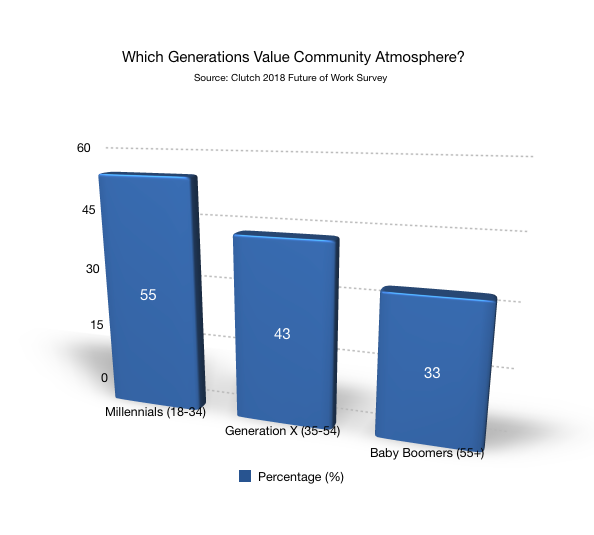Why do we need a community?
The recent global pandemic forced many to work from home, and with it came the realization that full-time remote work is perhaps not as easy as it sounds. Workplace loneliness, for instance, is a problem that cannot continue to be ignored. Loneliness also appears to be connected with motivation, and can eventually have an impact on worker productivity. Studies have revealed that while many workers of all ages value a community atmosphere, it is millennials that appear to value it the most. The Future of Work Survey 2018 by Clutch shows that nearly half the employees (47 percent) value a community atmosphere. With more millennials valuing the community, it appears that the future of work is headed towards being more community-centric than ever.

Source: https://clutch.co/hr/resources/future-of-work-how-workspaces-meet-worker-needs
The WorkWell Philosophy
The WorkWell philosophy from Max Estates is based on a standard called the WELL Building Standard that focuses solely on health and wellness. It takes into account environmental health, building design, human health as well as behavioral factors. There are seven categories that are given due consideration.
- Air
- Water
- Nourishment
- Light
- Fitness
- Comfort
- Mind
By putting in great effort into developing rainwater harvesting and groundwater recharging initiatives, lighting and acoustics, biophilia, wellness spaces and even nourishment initiatives such as organic vegetables and biotic food product sales, Max Towers and Max House have made the WorkWell mantra a central aspect of its planning.
A 5-Step Guide
There is no single way to achieve a vibrant community at the workspace, but a few steps can always prove to be effective.
#1 Workspace Design
Workplace architecture and design often play a surprisingly large role in how humans interact. A simple example would be the presence of a dining facility where workers come together every day.
Others include open spaces, an auditorium and even a ‘third space’ for employees to work. Considerations regarding ventilation, mobility, having green plants in the vicinity and general comfort in inhabiting these spaces are essential to set a strong foundation for collaborative relationships at the workplace.
#2 Value Human Relationships
A human-centric approach to community-building is imperative. A supportive workplace caters to the needs of the employees and strives to enhance their experiences, succeeding in creating lasting bonds between the workers. Culture managers specialize in bringing out the best in the community and providing people with the right opportunities.

#3 Events and Opportunities
This aspect is perhaps where managers can bring in the most creativity. Be it celebrating festivals or organizing workshops and conferences, meetings that allow employees to gather together help them know each other better. This helps employees feel included and valued, while also providing an avenue for networking and finding out how well they would collaborate.
#4 Look for the Right Tools
Technological tools can also be harnessed to bring people together. Message alerts regarding events and workshops and an online presence of the community members are always useful. The use of forms or polls can help managers gather feedback and suggestions from employees, which can then be used to further improve the workplace culture. For example, at Max Towers, a building App is deployed that can be used to visit meeting rooms, get alerts on events being organized by the building culture manager, order food and many other functionalities that not only aids to productivity but also drives feeling of community

#5 Focus on Wellness
Wellness is perhaps the most overlooked aspect of community-building. A gym or a pool at the workplace can provide much-needed breaks from monotony, while simultaneously helping employees to form unique bonds. The availability of wellness spaces that allow people to engage in sports or other recreational activities such as art and tours prove to be essential in helping workers to maintain fitness levels and overall health.
Conclusion
Creating a vibrant community in your workspace is as easy as it is imperative, and, therefore, workplaces have little excuse to ignore this any longer. Showing gratitude, having empathy and building trust can go a long way. A healthy community tends to be more productive and individuals support each other in their endeavors. Valuing human relationships can also help businesses to drive innovations and achieve better outcomes.
 0 comments
0 comments


